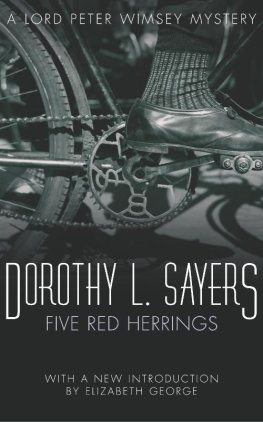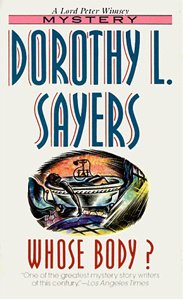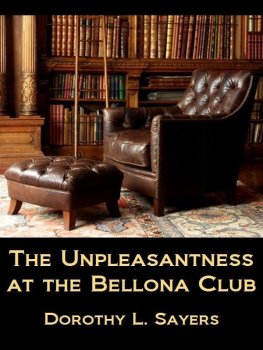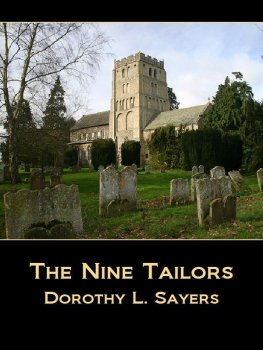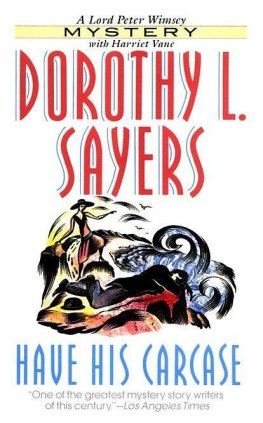Dorothy Sayers - Five Red Herrings
Here you can read online Dorothy Sayers - Five Red Herrings full text of the book (entire story) in english for free. Download pdf and epub, get meaning, cover and reviews about this ebook. genre: Detective and thriller. Description of the work, (preface) as well as reviews are available. Best literature library LitArk.com created for fans of good reading and offers a wide selection of genres:
Romance novel
Science fiction
Adventure
Detective
Science
History
Home and family
Prose
Art
Politics
Computer
Non-fiction
Religion
Business
Children
Humor
Choose a favorite category and find really read worthwhile books. Enjoy immersion in the world of imagination, feel the emotions of the characters or learn something new for yourself, make an fascinating discovery.
- Book:Five Red Herrings
- Author:
- Genre:
- Rating:4 / 5
- Favourites:Add to favourites
- Your mark:
- 80
- 1
- 2
- 3
- 4
- 5
Five Red Herrings: summary, description and annotation
We offer to read an annotation, description, summary or preface (depends on what the author of the book "Five Red Herrings" wrote himself). If you haven't found the necessary information about the book — write in the comments, we will try to find it.
Five Red Herrings — read online for free the complete book (whole text) full work
Below is the text of the book, divided by pages. System saving the place of the last page read, allows you to conveniently read the book "Five Red Herrings" online for free, without having to search again every time where you left off. Put a bookmark, and you can go to the page where you finished reading at any time.
Font size:
Interval:
Bookmark:
Dorothy L. Sayers
Five Red Herrings
FOREWORD
To my friend Joe Dignam,
kindliest of landlords
Dear Joe,
Here at last is your book about Gatehouse and Kirkcudbright. All the places are real places and all the trains are real trains, and all the landscapes are correct, except that I have run up a few new houses here and there. But you know better than anybody that none of the people are in the least like the real people, and that no Galloway artist would ever think of getting intoxicated or running away from his wife or bashing a fellow-citizen over the head. All that is just put in for fun and to make it more exciting.
If I have accidentally given any real persons name to a nasty character, please convey my apologies to that person, and assure him or her that it was entirely unintentional. Even bad characters have to be called something. And please tell Provost Laurie that though this story is laid in the petrol-gas period, I have not forgotten that Gatehouse will now have its electric light by which to read this book.
And if you should meet Mr. Millar of the Ellangowan Hotel, or the station-master at Gatehouse, or the booking-clerks at Kirkcudbright, or any of the hundred-and-one kindly people who so patiently answered my questions about railway-tickets and omnibuses and the old mines over at Creetown, give them my very best thanks for their assistance and my apologies for having bothered them so.
Give my love to everybody, not forgetting Felix, and tell Mrs. Dignam that we shall come back next summer to eat some more potato-scones at the Anwoth.
Dorothy L. Sayers.
CONTENTS
INTRODUCTION
I came to the wonderful detective novels of Dorothy L. Sayers in a way that would probably make that distinguished novelist spin in her grave. Years ago, actor Ian Carmichael starred in the film productions of a good chunk of them, which I eventually saw on my public television station in Huntington Beach, California. I recall the host of the show reciting the impressive, salient details of Sayers life and career early female graduate of Oxford, translator of Dante, among other things and I was much impressed. But I was even more impressed with her delightful sleuth Lord Peter Wimsey, and I soon sought out her novels.
Because I had never been and still am not today a great reader of detective fiction, I had not heard of this marvellous character. I quickly became swept up in everything about him: from his foppish use of language to his family relations. In very short order, I found myself thoroughly attached to Wimsey, to his calm and omnipresent manservant Bunter, to the Dowager Duchess of Denver (was ever there a more deliciously alliterative title?), to the stuffy Duke and the unbearable Duchess of Denver, to Viscount St. George, to Charles Parker, to Lady Mary. . In Dorothy L. Sayers novels, I found the sort of main character I loved when I turned to fiction: someone with a real life, someone who wasnt just a hero who conveniently had no relations to mess up the workings of the novelists plot.
Dorothy L. Sayers, as I discovered, had much to teach me both as a reader and as a future novelist. While many detective novelists from the Golden Age of mystery kept their plots pared down to the requisite crime, suspects, clues, and red herrings, Sayers did not limit herself to so limited a canvas in her work. She saw the crime and its ensuing investigation as merely the framework for a much larger story, the skeleton if you will upon which she could hang the muscles, organs, blood vessels and physical features of a much larger tale. She wrote what I like to call the tapestry novel, a book in which the setting is realised (from Oxford, to the dramatic coast of Devon, to the flat bleakness of the Fens), in which throughout both the plot and the subplots the characters serve functions surpassing that of mere actors on the stage of the criminal investigation, in which themes are explored, in which life and literary symbols are used, in which allusions to other literature abound. Sayers, in short, did what I call taking no prisoners in her approach to the detective novel. She did not write down to her readers; rather, she assumed that her readers would rise to her expectations of them.
I found in her novels a richness that I had not previously seen in detective fiction. I became absorbed in the careful application of detail that characterized her plots: whether she was educating me about bell ringing in The Nine Tailors, about the unusual uses of arsenic in Strong Poison, about the beauties of architectural Oxford in Gaudy Night. She wrote about everything from cryptology to vinology, making unforgettable that madcap period between wars that marked the death of an overt class system and heralded the beginning of an insidious one.
What continues to be remarkable about Sayers work, however, is her willingness to explore the human condition. The passions felt by characters created eighty years ago are as real today as they were then. The motives behind peoples behavior are no more complex now than they were in 1923 when Lord Peter Wimsey took his first public bow. Times have changed, rendering Sayers England in so many ways unrecognizable to todays reader. But one of the true pleasures inherent to picking up a Sayers novel now is to see how the times in which we live alter our perceptions of the world around us, while doing nothing at all to alter the core of our humanity.
When I first began my own career as a crime novelist, I told people that I would rest content if my name was ever mentioned positively in the same sentence as that of Dorothy L. Sayers. Im pleased to say that that occurred with the publication of my first novel. If I ever come close to offering the reader the details and delights that Sayers offered in her Wimsey novels, I shall consider myself a success indeed.
The reissuing of a Sayers novel is an event, to be sure. As successive generations of readers welcome her into their lives, they embark upon an unforgettable journey with an even more unforgettable companion. In time of dire and immediate trouble, one might well call upon a Sherlock Holmes for a quick solution to ones trials. But for the balm that reassures one about surviving the vicissitudes of life, one could do no better than to anchor onto a Lord Peter Wimsey.
Elizabeth George
Huntington Beach, CaliforniaMay 27, 2003
CAMPBELL QUICK
If one lives in Galloway, one either fishes or paints. Either is perhaps misleading, for most of the painters are fishers also in their spare time. To be neither of these things is considered odd and almost eccentric. Fish is the standard topic of conversation in the pub and the post-office, in the garage and the street, with every sort of person, from the man who arrives for the season with three Hardy rods and a Rolls-Royce, to the man who leads a curious, contemplative life, watching the salmon-nets on the Dee. Weather, which in other parts of the Kingdom is gauged by the standards of the farmer, the gardener, and the weekender, is considered in Galloway in terms of fish and paint. The fisherman-painter has the best of the bargain as far as the weather goes, for the weather that is too bright for the trout deluges his hills and his sea with floods of radiant colour; the rain that interrupts picture-making puts water into the rivers and the lochs and sends him hopefully forth with rod and creel; while on cold dull days, when there is neither purple on the hills nor fly on the river, he can join a friendly party in a cosy bar and exchange information about Cardinals and March Browns, and practise making intricate knots in gut.
The artistic centre of Galloway is Kirkcudbright, where the painters form a scattered constellation, whose nucleus is in the High Street, and whose outer stars twinkle in remote hillside cottages, radiating brightness as far as Gatehouse-of-Fleet. There are large and stately studios, panelled and high, in strong stone houses filled with gleaming brass and polished oak. There are workaday studios summer perching-places rather than settled homes where a good north light and a litter of brushes and canvas form the whole of the artistic stock-in-trade. There are little homely studios, gay with blue and red and yellow curtains and odd scraps of pottery, tucked away down narrow closes and adorned with gardens, where old-fashioned flowers riot in the rich and friendly soil. There are studios that are simply and solely barns, made beautiful by ample proportions and high-pitched rafters, and habitable by the addition of a tortoise stove and a gas-ring. There are artists who have large families and keep domestics in cap and apron; artists who engage rooms, and are taken care of by landladies; artists who live in couples or alone, with a woman who comes in to clean; artists who live hermit-like and do their own charing. There are painters in oils, painters in water-colours, painters in pastel, etchers and illustrators, workers in metal; artists of every variety, having this one thing in common that they take their work seriously and have no time for amateurs.
Font size:
Interval:
Bookmark:
Similar books «Five Red Herrings»
Look at similar books to Five Red Herrings. We have selected literature similar in name and meaning in the hope of providing readers with more options to find new, interesting, not yet read works.
Discussion, reviews of the book Five Red Herrings and just readers' own opinions. Leave your comments, write what you think about the work, its meaning or the main characters. Specify what exactly you liked and what you didn't like, and why you think so.

